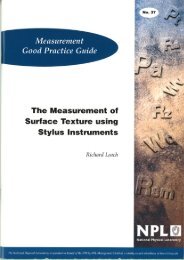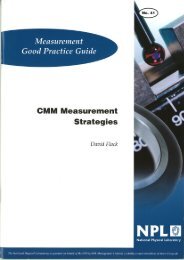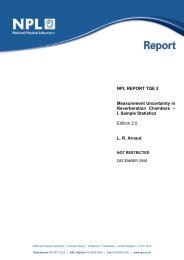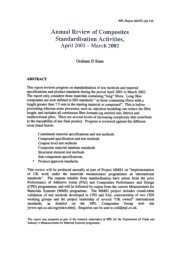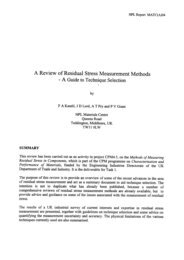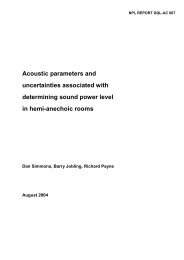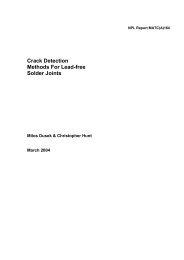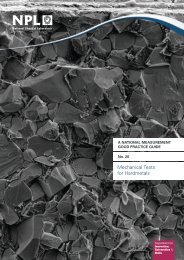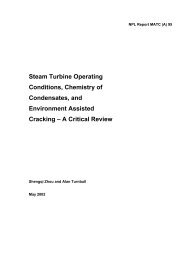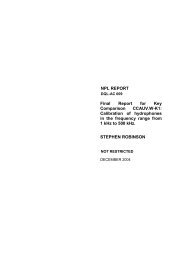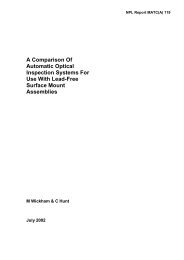Protocol for Establishing and Maintaining the Calibration - NPL ...
Protocol for Establishing and Maintaining the Calibration - NPL ...
Protocol for Establishing and Maintaining the Calibration - NPL ...
You also want an ePaper? Increase the reach of your titles
YUMPU automatically turns print PDFs into web optimized ePapers that Google loves.
10 Good Practice Guide 93 Chapter 1<br />
1.4 Additional Considerations<br />
1.4.1 Environmental Requirements<br />
Ideally <strong>the</strong> instrument should be used in a stable environment. The chamber should be mounted on<br />
a very firm, vibration-free base. The area must not be affected by high activity sources nearby <strong>and</strong><br />
this will often require extra shielding (see section 1.3.4). For reliability <strong>and</strong> stability, <strong>the</strong> calibrator<br />
should be operated at a reasonably constant temperature. Direct sunlight or proximity to a room<br />
heater or air conditioner should be avoided. Excessive humidity should also be avoided.<br />
1.4.2 Power Requirements<br />
No special power requirements are normally necessary. The line voltage required will be stated in<br />
<strong>the</strong> user manual. For optimum per<strong>for</strong>mance, <strong>the</strong> unit should be left powered at all times. The use<br />
of a mains interference filter <strong>and</strong> an uninterruptible power supply (UPS) is recommended.<br />
1.4.3 Shielding<br />
An effective way of reducing <strong>the</strong> effects of local environment radiation is to shield <strong>the</strong> ionisation<br />
chamber, usually with lead. Shielding also helps to minimise <strong>the</strong> dose to <strong>the</strong> operator whilst a<br />
radioactive source is in <strong>the</strong> ionisation chamber. The shield may be provided by <strong>the</strong> manufacturer<br />
ei<strong>the</strong>r as an integral part of <strong>the</strong> chamber module or as a removable outer sleeve; alternatively it may<br />
be constructed "in-house" by <strong>the</strong> user as <strong>the</strong> only <strong>for</strong>m of shielding or in addition to that already<br />
provided with <strong>the</strong> chamber.<br />
It is important to note that shielding will alter <strong>the</strong> calibration factors to an extent that is dependent<br />
on <strong>the</strong> type <strong>and</strong> proximity of <strong>the</strong> shielding. This arises from back-scattering of photons from <strong>the</strong><br />
source after <strong>the</strong>y emerge from <strong>the</strong> outer surface of <strong>the</strong> chamber toge<strong>the</strong>r with <strong>the</strong> emission of Pb K<br />
X-rays arising from interactions within <strong>the</strong> lead shielding. Typically, <strong>the</strong> combination of <strong>the</strong>se two<br />
events results in an enhancement of <strong>the</strong> chamber response, which maximises in <strong>the</strong> region of 80<br />
keV. As such, those radionuclides, which are ideal <strong>for</strong> imaging purposes also suffer most from this<br />
effect. It is important <strong>the</strong>re<strong>for</strong>e to determine <strong>the</strong> shielding arrangements which apply <strong>for</strong> <strong>the</strong><br />
calibration settings provided by <strong>the</strong> manufacturer. If additional shielding is introduced,<br />
comparative measurements should be made with <strong>and</strong> without <strong>the</strong> additional shielding to determine<br />
<strong>the</strong> correction factors that will need to be applied.<br />
1.5 Quality Assurance <strong>and</strong> Documentation<br />
Results of UK hospital exercises conducted over <strong>the</strong> years by <strong>NPL</strong> <strong>for</strong> a wide range of medical<br />
radionuclides illustrate a wide variation of response, even <strong>for</strong> those using chambers of <strong>the</strong> same<br />
model. They also demonstrate that it is related to <strong>the</strong> average energy of <strong>the</strong> photon radiation being<br />
measured: <strong>the</strong> lower <strong>the</strong> photon energy, <strong>the</strong> wider <strong>the</strong> variation. This is demonstrated in Table 1.3,<br />
which examines <strong>the</strong> spread of responses <strong>for</strong> a particular radionuclide in terms of <strong>the</strong> fraction of<br />
results which lie within a given range of <strong>the</strong> true value. The results have been presented in<br />
ascending order of average photon energy (results from a recent comparison of a pure beta emitter,<br />
89 Sr, have also been included).



